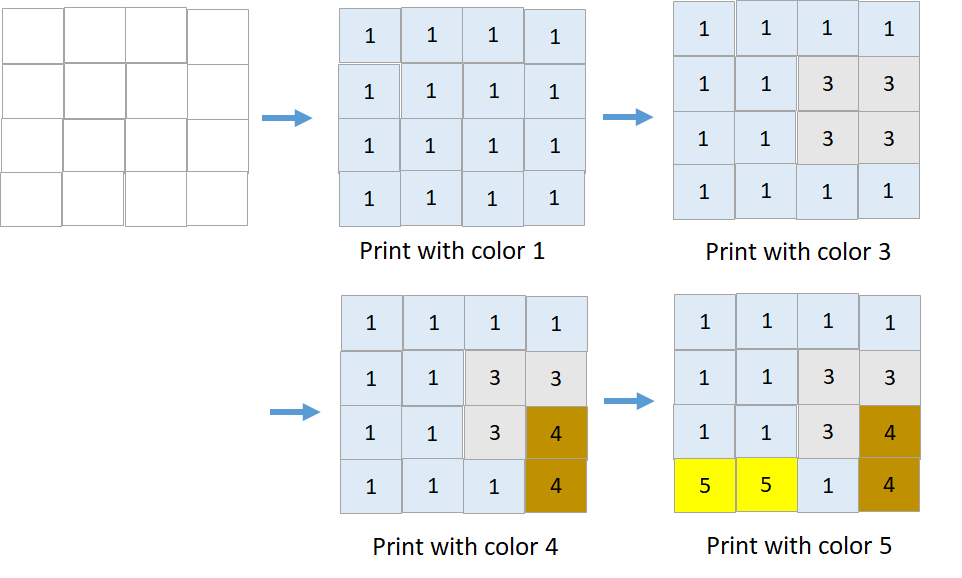Welcome to Subscribe On Youtube
Formatted question description: https://leetcode.ca/all/1591.html
1591. Strange Printer II (Hard)
There is a strange printer with the following two special requirements:
- On each turn, the printer will print a solid rectangular pattern of a single color on the grid. This will cover up the existing colors in the rectangle.
- Once the printer has used a color for the above operation, the same color cannot be used again.
You are given a m x n matrix targetGrid, where targetGrid[row][col] is the color in the position (row, col) of the grid.
Return true if it is possible to print the matrix targetGrid, otherwise, return false.
Example 1:

Input: targetGrid = [[1,1,1,1],[1,2,2,1],[1,2,2,1],[1,1,1,1]] Output: true
Example 2:

Input: targetGrid = [[1,1,1,1],[1,1,3,3],[1,1,3,4],[5,5,1,4]] Output: true
Example 3:
Input: targetGrid = [[1,2,1],[2,1,2],[1,2,1]] Output: false Explanation: It is impossible to form targetGrid because it is not allowed to print the same color in different turns.
Example 4:
Input: targetGrid = [[1,1,1],[3,1,3]] Output: false
Constraints:
m == targetGrid.lengthn == targetGrid[i].length1 <= m, n <= 601 <= targetGrid[row][col] <= 60
Related Topics:
Greedy
Similar Questions:
Solution 1.
-
class Solution { public boolean isPrintable(int[][] targetGrid) { Map<Integer, int[]> boundsMap = new HashMap<Integer, int[]>(); int rows = targetGrid.length, columns = targetGrid[0].length; for (int i = 0; i < rows; i++) { for (int j = 0; j < columns; j++) { int color = targetGrid[i][j]; if (!boundsMap.containsKey(color)) boundsMap.put(color, new int[]{i, i, j, j}); else { int[] bounds = boundsMap.get(color); bounds[0] = Math.min(bounds[0], i); bounds[1] = Math.max(bounds[1], i); bounds[2] = Math.min(bounds[2], j); bounds[3] = Math.max(bounds[3], j); boundsMap.put(color, bounds); } } } Set<Integer> keySet = boundsMap.keySet(); Map<Integer, List<Integer>> greaterMap = new HashMap<Integer, List<Integer>>(); for (int i = 0; i < rows; i++) { for (int j = 0; j < columns; j++) { int color = targetGrid[i][j]; List<Integer> list = greaterMap.getOrDefault(color, new ArrayList<Integer>()); for (int key : keySet) { if (key != color) { int[] bounds = boundsMap.get(key); if (i >= bounds[0] && i <= bounds[1] && j >= bounds[2] && j <= bounds[3]) list.add(key); } } greaterMap.put(color, list); } } Map<Integer, Integer> indegreeMap = new HashMap<Integer, Integer>(); for (int color : keySet) { List<Integer> nextColors = greaterMap.getOrDefault(color, new ArrayList<Integer>()); for (int nextColor : nextColors) { int indegree = indegreeMap.getOrDefault(nextColor, 0) + 1; indegreeMap.put(nextColor, indegree); } } Set<Integer> visited = new HashSet<Integer>(); Queue<Integer> queue = new LinkedList<Integer>(); for (int color : keySet) { int indegree = indegreeMap.getOrDefault(color, 0); if (indegree == 0) { visited.add(color); queue.offer(color); } } while (!queue.isEmpty()) { int color = queue.poll(); List<Integer> nextColors = greaterMap.getOrDefault(color, new ArrayList<Integer>()); for (int nextColor : nextColors) { int indegree = indegreeMap.getOrDefault(nextColor, 0) - 1; if (indegree == 0) { indegreeMap.remove(nextColor); visited.add(nextColor); queue.offer(nextColor); } else indegreeMap.put(nextColor, indegree); } } return visited.size() == keySet.size(); } } -
// OJ: https://leetcode.com/problems/strange-printer-ii/ // Time: O(C^2 * MN) // Space: O(MN) class Solution { bool removable(vector<vector<int>> &G, vector<vector<int>> &pos, int c) { for (int i = pos[c][0]; i <= pos[c][2]; ++i) { for (int j = pos[c][1]; j <= pos[c][3]; ++j) { if (G[i][j] != c && G[i][j] != 0) return false; } } for (int i = pos[c][0]; i <= pos[c][2]; ++i) { for (int j = pos[c][1]; j <= pos[c][3]; ++j) G[i][j] = 0; } return true; } public: bool isPrintable(vector<vector<int>>& G) { int M = G.size(), N = G[0].size(); vector<vector<int>> pos(61, {M, N, 0, 0}); unordered_set<int> colors, remove; for (int i = 0; i < M; ++i) { for (int j = 0; j < N; ++j) { int c = G[i][j]; colors.insert(c); pos[c][0] = min(pos[c][0], i); pos[c][1] = min(pos[c][1], j); pos[c][2] = max(pos[c][2], i); pos[c][3] = max(pos[c][3], j); } } while (colors.size()) { for (int c : colors) { if (removable(G, pos, c)) remove.insert(c); } if (remove.empty()) return false; for (int c : remove) colors.erase(c); remove.clear(); } return true; } };